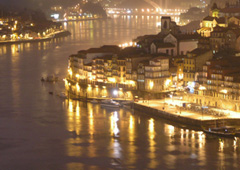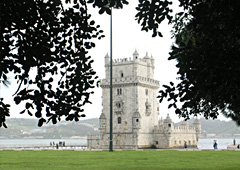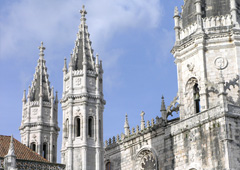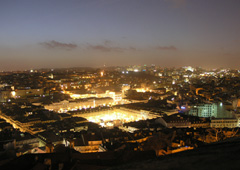Porto
The next morning brought cold rain and an early departure for Porto, further to the north. Portugal’s second largest city and famed for its sweet Port wine, Porto stands gracefully above the northern banks of the Douro River. Arriving on the train, the first thing a visitor will notice are the towering bridges that connect Porto and its more modern neighbour Vila Nova de Gaia. One such span, the Dom Luís I Bridge, arches majestically over the river and brings to mind images of Paris’ Eiffel Tower. This is no accident; the bridge’s designer, Léopold Valentin, was one of Gustav Eiffel’s young protégés.
 The lights of Ribeira glisten in the cool night air, the historic center of Porto, declared a UNESCO World Heritage Site in 1996 (Portugal’s 8th)Parts of Porto, with boarded up buildings and scrawled graffiti, hint at the city’s hard-scrabble past as a shipping port and decades of economic despondency. Closer to the Douro River, the buildings are older and the area more well-preserved. Riberia, belying Porto’s more recent economic struggles, is an exquisite gem of august architecture, fine restaurants and majestic bridges. UNESCO certainly thought so, naming Riberia a World Heritage Site in 1996. Dining on Portugal’s superb cuisine and sweet Port wine with the Don Luis I alight in the darkness as a backdrop is truly a singular pleasure.
The lights of Ribeira glisten in the cool night air, the historic center of Porto, declared a UNESCO World Heritage Site in 1996 (Portugal’s 8th)Parts of Porto, with boarded up buildings and scrawled graffiti, hint at the city’s hard-scrabble past as a shipping port and decades of economic despondency. Closer to the Douro River, the buildings are older and the area more well-preserved. Riberia, belying Porto’s more recent economic struggles, is an exquisite gem of august architecture, fine restaurants and majestic bridges. UNESCO certainly thought so, naming Riberia a World Heritage Site in 1996. Dining on Portugal’s superb cuisine and sweet Port wine with the Don Luis I alight in the darkness as a backdrop is truly a singular pleasure.
Lisbon, Once Again
After a short train ride from Porto, I was once again in Lisbon for the final days of my journey. Arriving into Lisbon via train is an aesthetic pleasure. Gradually you close in to the city, with its stately hills falling into the broad Tagus river-side. The train then pulls into Oriente Station, its radiant lattice-work canopy towering high above the station platform. Designed by Spanish master Santiago Calatrava, the station is further part of the 1998 World Expo complex. After a quick check-in at the hotel, I again set out onto the streets of Lisbon ready for my next discovery.
Museu Nacional de Arte Antiga
While exploring Barrio Alto, I stumbled upon one of Lisbon’s great museums, the Museu Nacional de Arte Antiga. Given the nation’s religious tradition, the crucifixion of Christ is a reoccurring theme in this museum’s bountiful collection. Through a wide variety of media, Christ is depicted in graphic detail dragging his cross, being nailed to it, suffering almightily for our sins, dying and, finally, blessedly, being removed from said cross and laid to rest in a cave, ready for his imminent resurrection. The excruciating exactitude of many of the works border on the macabre. Alas, much of the rest of the museum was closed for renovation, so Christ’s allegorical agony will be my most vivid memory of the Museu Nacional de Arte Antiga.
Belém Tower and the Mosteiro dos Jerónimos
 With the nearby Mosteiro dos Jeronimos, Belem Tower tower was classified a National Monument in 1910 and a World Heritage Site in 1983Not wanting to waste time, I caught an aging Mercedes taxi that bounced along cobble-stone streets to Belém Tower. Standing guard at the mouth of the Tagus River, the alabaster tower is a sight to behold. Built in the to commemorate the expedition of Vasco de Gama and as part of the city’s defensive system, Belém Tower has since become a widely-recognized symbol of Lisbon. And rightly so, the tower’s elegant stone-work and refined form make for a striking gateway into the city while handsomely disavowing the Tower’s original militaristic intention.
With the nearby Mosteiro dos Jeronimos, Belem Tower tower was classified a National Monument in 1910 and a World Heritage Site in 1983Not wanting to waste time, I caught an aging Mercedes taxi that bounced along cobble-stone streets to Belém Tower. Standing guard at the mouth of the Tagus River, the alabaster tower is a sight to behold. Built in the to commemorate the expedition of Vasco de Gama and as part of the city’s defensive system, Belém Tower has since become a widely-recognized symbol of Lisbon. And rightly so, the tower’s elegant stone-work and refined form make for a striking gateway into the city while handsomely disavowing the Tower’s original militaristic intention.
A short walk from Belém Tower is Mosteiro dos Jerónimos (Jerónimos Monastery) and the Church of Santa Maria, the three together composing UNESCO’s 263rd World Heritage Site. Built by Manuel I to commemorate Vasco da Gama’s return from India, the church and monastery are true products of Portugal’s “Age of Discovery”. Replete with intricate nautical motifs and design influences from around the known world, the complex is a sight to behold.
 Intended for the burial of the House of Aviz, the Church of Santa Maria instead became a house of prayer for departing Portuguese marinersMost immediate is the church, an opulent mix of Gothic and Renaissance styles and considered one of the most magnificent works of its time. Inside, cascades of light from the setting sun flood the vaulted interior, the raised crucifix casting a deep shadow across worshipers below. The warm illumination fills the nave with an unearthly radiance. It is easy to imagine adventuresome explorers receiving divine inspiration while praying before their next voyage into the unknown.
Intended for the burial of the House of Aviz, the Church of Santa Maria instead became a house of prayer for departing Portuguese marinersMost immediate is the church, an opulent mix of Gothic and Renaissance styles and considered one of the most magnificent works of its time. Inside, cascades of light from the setting sun flood the vaulted interior, the raised crucifix casting a deep shadow across worshipers below. The warm illumination fills the nave with an unearthly radiance. It is easy to imagine adventuresome explorers receiving divine inspiration while praying before their next voyage into the unknown.
Just beyond the church is the Jerónimos Monastery, a sumptuous late-Gothic cloister built using pedra lioz, a local gold-colored limestone. Fittingly, the construction was funded with a 5% tax on the spice trade. The riches of the spice trade allowed the designers wide latitude, resulting in resplendent ornamentation throughout the majestic passageways and cloister. A recent renovation has restored the gold limestone to its original glory.
Castle of São Jorge
 While darkness descends on Lisbon, as viewed from Castle Sao Jorge, the city begins to awake with the sights and sounds of celebrationsWith the daylight quickly receding, I hailed an ancient Mercedes taxi and sped across Lisbon’s narrow and jarring cobblestone streets to the Castle of São Jorge. Situated on the highest hill in the city and at the heart of historic Lisbon, the Castle of São Jorge occupies a commanding point above the capital. The castle’s towering citadel, with its narrow passages and precipitous heights, make for adventurous exploration. It is also an ideal vantage point to enjoy the shimmering threads of light that twist through the Lisbon metropolis.
While darkness descends on Lisbon, as viewed from Castle Sao Jorge, the city begins to awake with the sights and sounds of celebrationsWith the daylight quickly receding, I hailed an ancient Mercedes taxi and sped across Lisbon’s narrow and jarring cobblestone streets to the Castle of São Jorge. Situated on the highest hill in the city and at the heart of historic Lisbon, the Castle of São Jorge occupies a commanding point above the capital. The castle’s towering citadel, with its narrow passages and precipitous heights, make for adventurous exploration. It is also an ideal vantage point to enjoy the shimmering threads of light that twist through the Lisbon metropolis.
With the day put to rest and another lively Lisbon night awaking, the view was a perfect coda to another fantastic journey. The following day would bring a day of lengthy flights, customs queues and the myriad of travels facing the modern traveler. Through it all, it was poetic to be returning to the new world on trails blazed by Portuguese explorers so many years before.
Your photography (the Portugal images as well as the South American ones) is really quite good, thank you for sharing.